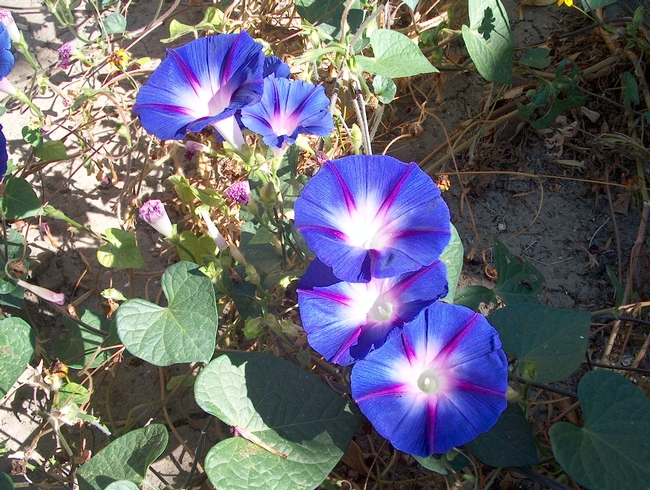
There have been many times that I have considered purchasing a machete. What better way to eradicate gardening blunders, and in such a flamboyant manner? I make many of my mistakes through ignorance and often from just not reading instructions.
I own two plants that might not be considered invasive plants, but they definitely have invaded my garden and most assuredly are mistakes. They are Potentilla and morning glory.
More than 20 years ago, when I was just starting out in the gardening game, I was looking to do something in my side yard. The space runs the full length of the house—about 45 feet—and is about 7 feet wide. I was looking for an easy fix that required little or no maintenance but would be pleasant to look at.
My husband and I were in the midst of raising three kids and working 40 hours a week, after all. Being an inexperienced gardener, I did not realize that the traits I sought are rarely found together.My research turned up a groundcover called Potentilla. With its deep green ground-hugging foliage, cute yellow flowers and low water requirements, what's not to love? I ordered several flats and proceeded to plant the Potentilla in the side yard.
Had I done more research and asked around, I would have found out Potentilla's true nature and perhaps decided against it. I can only imagine that the person responsible for naming this plant did so with tongue in cheek. I mean, it is truly “potent.”Virtually impossible to assassinate.
Potentilla is now growing throughout my entire yard:popping up in the lawn, in all the garden beds, around the copping on the pool, everywhere. Every year it gets a rust fungus that is hard to eliminate. Part of each time segment I spend in the garden is dedicated to Potentilla patrol. I see no end in sight. It must be said, though, that the side yard looks great.
You would think that I would have learned my lesson and not committed a similar error again. In my defense, perhaps my head was so swollen with pride at my recent graduation from the University of California's Master Gardener program that I wasn't thinking clearly. When I received a congratulatory card with morning glory seeds enclosed, I lost my mind and planted them. This packet of seeds turned intothe gift that keeps on giving.“Big mistake” hardly describes the situation.
True, the morning glory flowers are fun and beautiful to look at. The phrase “a riot of color” comes to mind. They bloom in the morning, as their name suggests, and are largely closed by noon. A small seedling becomes avine that clambers up and over virtually any obstacle to create a carpet of color.
So what's the problem? First, because they are annuals, they die back in cold weather and go to seed. So now your landscape is festooned with yards of spent vines. I learned the hard way that you need to pull the vines down before they go to seed. If you wait until the vines are dry and the seeds are falling or ready to fall, pulling the vines down unleashes a shower of seeds.
The propagation potential is frightful enough, but to add insult to injury, the seeds are poisonous. Birds, normally nature's little vacuum cleaners, will not touch them. The seeds also endanger people and pets. The toxicity is mild to moderate but common effects include diarrhea, anemia, uncoordinated movements and liver failure, depending on how much was ingested.
So now I not only have to remove the vines but I practically have to use tweezers to pick up all the seeds. Any seeds that I miss will grow into a plant in the spring, repeating the entire cycle. Maybe morning glory is lovely in the wild.In my yard, not so much.
The moral to the story is, research a plant's characteristics and growth patterns before planting it. Ask at local nurseries, consult your neighbors and look online. The Napa County Master Gardeners staff a help desk to give advice and planting information. Check our website (address below). Avail yourself of these resources before you, too, find yourself on Potentilla patrol.
Tomato Sale and Education Event: Napa County Master Gardeners are hosting their third annual Tomato Sale on Saturday, April 18. Join us in the South Oxbow parking lot in Napa, 9 a.m. until sold out. We have a bountiful selection of strong, young plants: heirlooms, hybrids, cherry, paste and just plain good eating tomatoes of all sizes. Remember to bring your own box to safely transport your plants home. Click on the link above to read descriptions of the varieties for sale.
Master Gardeners are volunteers who help the University of California reach the gardening public with home gardening information. Napa County Master Gardeners ( http://ucanr.org/ucmgnapa/) are available to answer gardening questions in person or by phone, Monday, Wednesday and Friday, 9 a.m. to Noon, at the U. C. Cooperative Extension office, 1710Soscol Avenue, Suite 4, Napa, 707-253-4143, or from outside City of Napa toll-free at 877-279-3065. Or e-mail your garden questions
questions by following the guidelines on our web site. Click on Napa, then on Have Garden Questions? Find us on Facebook under UC Master Gardeners of Napa County.
Attached Images:
